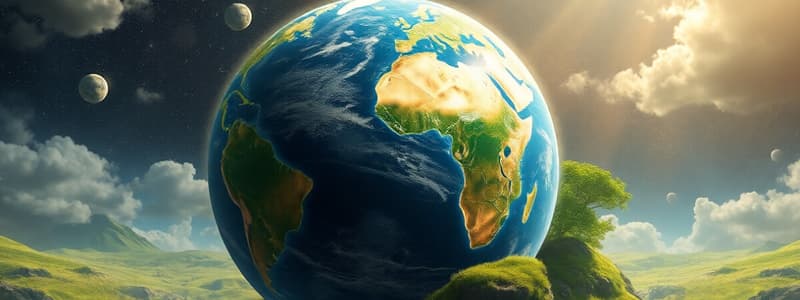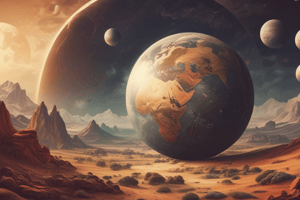Podcast
Questions and Answers
Which of the following best describes the focus of geography as a discipline?
Which of the following best describes the focus of geography as a discipline?
- The study of the Earth's physical features, and the relationship between people and their environment. (correct)
- The study of historical events and their impact on society.
- The study of the solar system, stars, and galaxies.
- The study of chemical reactions and the composition of matter.
Processes and patterns that occur naturally but are altered by humans are considered part of the 'physical environment' in geography.
Processes and patterns that occur naturally but are altered by humans are considered part of the 'physical environment' in geography.
False (B)
Which of the following is NOT one of the Earth's spheres?
Which of the following is NOT one of the Earth's spheres?
- Lithosphere
- Hydrosphere
- Atmosphere
- Magnetosphere (correct)
What term describes how geographical features are arranged across an area in a particular way?
What term describes how geographical features are arranged across an area in a particular way?
What is the primary function of a map scale?
What is the primary function of a map scale?
Resources that are replenished naturally within a relatively short time period are classified as ______ resources.
Resources that are replenished naturally within a relatively short time period are classified as ______ resources.
Which of the following is an example of a non-renewable resource?
Which of the following is an example of a non-renewable resource?
Culture and technology do not influence the identification of resources.
Culture and technology do not influence the identification of resources.
Match the following terms with their descriptions:
Match the following terms with their descriptions:
According to the provided material, what conditions are needed for herogen to form?
According to the provided material, what conditions are needed for herogen to form?
Which of the following is an example of 'Reuse' according to the 4 R's?
Which of the following is an example of 'Reuse' according to the 4 R's?
Most of the Earth's water is fresh water.
Most of the Earth's water is fresh water.
What is the environmental footprint?
What is the environmental footprint?
The lithosphere provides the ______ for continents.
The lithosphere provides the ______ for continents.
Which of the following processes is part of the water cycle?
Which of the following processes is part of the water cycle?
According to a nature-centered view, how should natural resources be managed?
According to a nature-centered view, how should natural resources be managed?
Marine plants and animals decompose completely on the seabed, allowing for the formation of oil and natural gas
Marine plants and animals decompose completely on the seabed, allowing for the formation of oil and natural gas
What are the 4 R's of Encourage conservation?
What are the 4 R's of Encourage conservation?
The angular distance of a place north or south of the equator is called ______.
The angular distance of a place north or south of the equator is called ______.
Which of the following is the most accurate description of what an ecosystem is?
Which of the following is the most accurate description of what an ecosystem is?
Flashcards
What is geography?
What is geography?
Study of places and the relationships between people and their environment.
Geographical concepts
Geographical concepts
Concepts used to understand spatial relationships and the connections between humans and their environment, including Space, Place, Environment and Scale.
Physical Environment
Physical Environment
Living and non-living things found naturally, processes, and patterns not altered by humans.
Human/built Environment
Human/built Environment
Signup and view all the flashcards
Atmosphere
Atmosphere
Signup and view all the flashcards
Lithosphere
Lithosphere
Signup and view all the flashcards
Hydrosphere
Hydrosphere
Signup and view all the flashcards
Biosphere
Biosphere
Signup and view all the flashcards
Spatial pattern
Spatial pattern
Signup and view all the flashcards
Place
Place
Signup and view all the flashcards
What are resources?
What are resources?
Signup and view all the flashcards
What is a natural resource?
What is a natural resource?
Signup and view all the flashcards
Renewable resources
Renewable resources
Signup and view all the flashcards
Non-renewable resources
Non-renewable resources
Signup and view all the flashcards
Nature-centred View
Nature-centred View
Signup and view all the flashcards
Human-centred View
Human-centred View
Signup and view all the flashcards
Conservation
Conservation
Signup and view all the flashcards
Preservation
Preservation
Signup and view all the flashcards
Reuse
Reuse
Signup and view all the flashcards
Recover
Recover
Signup and view all the flashcards
Study Notes
- Geography is the study of places and the relationships between people and their environments.
Geographical Concepts
- Key concepts include space, place, environment, and scale.
Environment Types
- Physical environments include living and non-living things that occur naturally, alongside processes and patterns unaltered by humans, such as rock formations, rivers, and forests.
- Human or built environments are shaped by interactions between humans and their natural surroundings, such as housing.
Earth's Spheres
- The Atmosphere is made of nitrogen, oxygen, carbon dioxide, and other gases, and acts as a blanket shielding from radiation.
- The Lithosphere provides the foundation for continents, making up the Earth’s crust, mantle, and tectonic plates, serving as a resource.
- The Hydrosphere includes all water on Earth, including glaciers, providing water to all living organisms.
- The Biosphere comprises living things that interact with each other in diverse ecosystems.
Spatial Patterns
- Geographical features arranged across an area in a particular way form a spatial pattern.
- Settlement patterns can be dispersed, linear, or nucleated.
Place
- Place refers to an area that holds a special meaning.
Scale
- Map scales make things easier to manage on maps.
- Map scales can be expressed as a statement, written as a line scale, or as a representative fraction.
Resources
- Resources are materials that are useful to humans, such as wood, cars, food, gas, electricity, water, and minerals.
- A natural resource is a useful material that occurs naturally in the physical environment.
- Types of resources include energy, ore, fuel, atmosphere, forest, and biological resources.
Factors Determining Material Usefulness
- Culture, which is a way of life, and technology, which includes ideas, concepts, and knowledge, influence people's ability to identify resources.
Natural Resource Types
- Renewable resources are replenished naturally more or less within the same time period when they are used and are considered to be unlimited in supply.
- Examples of renewable resources are geothermal energy, wind power, food, solar energy, wave energy, and tropical rainforests.
- Non-renewable resources result from natural processes that occur very slowly, taking a long time beyond the period of use, and their availability is limited.
- Examples of non-renewable resources are natural gas, gold, iron ore, crude oil (fossil fuels), coal, and diamond.
Formation of Oil and Natural Gas
- Coal, oil, and natural gas are made up of: algae, microscopic animals and plants, known as Herogen.
- Herogen formation requires pressure, high heat and an absence of oxygen.
- Marine plants and animals die, sink to the bottom of the seabed without fully rotting, and are buried under sediments.
- Partial decomposition occurs due to the oxygen-deprived site, chemical changes turn remains into oil and natural gas.
Contrasting Environmental Views
- A nature-centered view values the physical environment and its natural resources as valuable in themselves that should be preserved and retained in their original state, minimised or even prohibited for people’s use
- A human-centered view values the physical environment and its natural resources only because humans can obtain materials from it for their use and benefit, the motivation to extract natural resources from the physical environment enhances personal well-being or generates money.
Conservation vs. Preservation
- Conservation is the management of resources in a responsible and effective way, emphasizing the 4 R's: reduce, reuse, recycle, and recover.
- Preservation focuses on protecting and retaining resources or the environment in its original state as far as possible.
Reuse and Recover Defined
- Reuse involves re-purposing items to reduce the need to buy new items, which reduces the usage of natural resources.
- Recover involves recovering useful materials from the waste we produce, such as composing.
Environmental Footprint
- Environmental footprint measures the amount of land required to make a product for people’s use and to absorb the waste generated in its production.
Water Distribution
- Ocean water makes up 97% and fresh water makes up 3% of Earth's water.
- Fresh water comprises 70% glacier, 29% groundwater and 1% rivers and lakes.
Geography Concepts Recap
- Geography concepts include: space, place, environment and scale.
- Physical attributes include: Lithosphere, Hydrosphere, Biosphere, Atmosphere.
- Geographical considerations include local, regional, national, and global perspectives.
Map Work
- Latitude is measured North and South.
- Longitude is measured East and West.
- The latitude of the Tropic of Cancer is 23.5° N.
- The latitude of the Tropic of Capricorn is 23.5° S.
Studying That Suits You
Use AI to generate personalized quizzes and flashcards to suit your learning preferences.




